The Monitoring Tool Market is estimated to be valued at USD 30.4 billion in 2025 and is projected to reach USD 206.2 billion by 2035, registering a compound annual growth rate (CAGR) of 21.1% over the forecast period.
The Monitoring Tool market is experiencing robust growth, driven by the increasing complexity of IT infrastructure, rising digital transformation initiatives, and the growing need for proactive performance management across organizations. Demand is being fueled by the need to ensure high availability, reliability, and efficiency of enterprise applications and networks while reducing downtime and operational costs.
Cloud computing adoption, hybrid IT environments, and the rise of DevOps practices are shaping market dynamics, as organizations seek real-time monitoring and automated analytics to manage resources effectively. Advanced monitoring solutions now leverage AI and machine learning to predict potential failures, optimize performance, and improve service delivery.
Integration with IT service management and analytics platforms enhances operational visibility and informed decision-making As organizations prioritize scalability, automation, and security, the market is expected to sustain growth, with investments in cloud-based solutions and intelligent monitoring tools supporting enhanced efficiency and operational resilience across diverse industries.
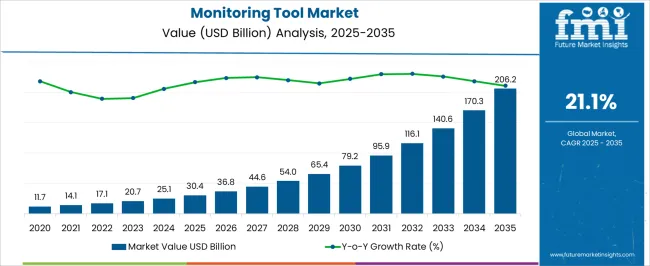
| Metric | Value |
|---|---|
| Monitoring Tool Market Estimated Value in (2025 E) | USD 30.4 billion |
| Monitoring Tool Market Forecast Value in (2035 F) | USD 206.2 billion |
| Forecast CAGR (2025 to 2035) | 21.1% |
The market is segmented by Component, Deployment, Type, and Vertical and region. By Component, the market is divided into Software and Services. In terms of Deployment, the market is classified into Cloud and On-Premises. Based on Type, the market is segmented into Infrastructure Monitoring Tools, Application Performance Monitoring Tools, Security Monitoring Tools, and End User Experience Monitoring Tools. By Vertical, the market is divided into BFSI, Retail & E-Commerce, Healthcare, IT & Telecom, Media & Entertainment, Manufacturing, and Others. Regionally, the market is classified into North America, Latin America, Western Europe, Eastern Europe, Balkan & Baltic Countries, Russia & Belarus, Central Asia, East Asia, South Asia & Pacific, and the Middle East & Africa.
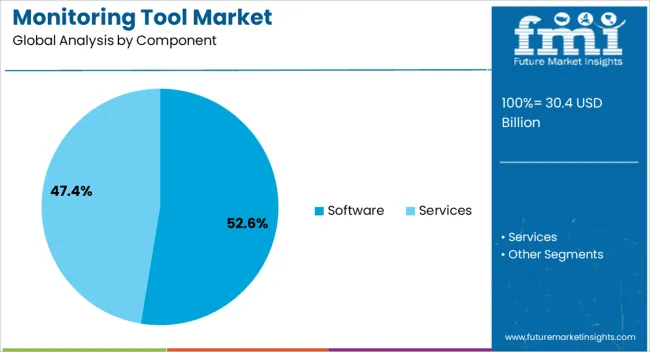
The software component segment is projected to hold 52.6% of the market revenue in 2025, establishing it as the leading component type. Its growth is being driven by the flexibility, scalability, and real-time capabilities that software solutions provide in monitoring enterprise applications, networks, and IT systems. Software tools enable continuous performance tracking, predictive analysis, and automated alerting, reducing the risk of downtime and improving operational efficiency.
Integration with cloud platforms, analytics engines, and IT service management systems enhances decision-making capabilities. Software-based monitoring also allows organizations to adapt quickly to evolving IT environments, including hybrid and multi-cloud infrastructures, without significant hardware investments.
The ability to deliver centralized management, advanced reporting, and actionable insights further strengthens adoption across enterprises As businesses continue to prioritize agility, scalability, and data-driven IT operations, the software segment is expected to maintain its leadership position, driven by continuous innovation in intelligent monitoring capabilities and cloud integration.
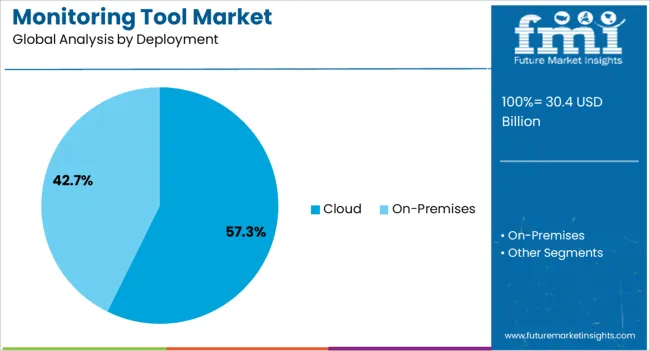
The cloud deployment segment is anticipated to account for 57.3% of the market revenue in 2025, making it the leading deployment category. Its growth is fueled by the increasing adoption of cloud infrastructure, hybrid IT models, and the need for scalable monitoring solutions that provide real-time visibility across distributed environments. Cloud-based monitoring tools offer centralized management, automated updates, and seamless integration with existing enterprise systems, reducing operational complexity and IT overhead.
Organizations benefit from predictive analytics, resource optimization, and performance monitoring without the constraints of on-premises infrastructure. Security, reliability, and compliance requirements are further supporting cloud deployment, as tools can be rapidly updated to address emerging risks.
The flexibility and cost-efficiency of cloud solutions make them particularly suitable for enterprises managing dynamic workloads and multiple applications As cloud adoption continues to rise globally, this deployment segment is expected to remain the dominant contributor, driven by increasing digital transformation initiatives and demand for agile IT operations.
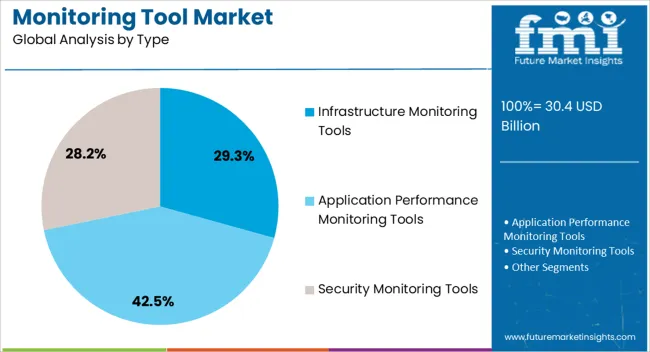
The infrastructure monitoring tools type segment is projected to hold 29.3% of the market revenue in 2025, positioning it as the leading tool category. Growth is being driven by the need for organizations to maintain optimal performance of servers, networks, storage, and other critical IT infrastructure components. These tools provide real-time monitoring, alerting, and predictive analytics that reduce downtime, improve service delivery, and enhance operational efficiency.
Integration with cloud platforms and software-based monitoring solutions allows for centralized visibility and improved management across hybrid environments. Increasing complexity in IT operations, combined with the rising adoption of virtualized and containerized infrastructures, has further fueled demand.
Infrastructure monitoring tools enable proactive identification of issues, resource optimization, and adherence to performance and compliance standards As enterprises increasingly adopt digital-first strategies, the infrastructure monitoring tools segment is expected to sustain its leading position, supported by continuous innovation in AI-driven analytics and integration with broader IT management ecosystems.
In 2020, the global monitoring tool market showed a potential worth USD 11.7 billion, according to a report from Future Market Insights (FMI). The monitoring tool market witnessed significant growth, registering a CAGR of 24.9% from 2020 to 2025.
| Historical CAGR | 24.9% |
|---|---|
| Forecast CAGR | 21.1% |
The demand for monitoring tools across various industries was on the verge of improvement, such as adopting digital technologies, proliferating Internet of Things (IoT) devices, and the augmenting need for real-time data analysis and insights contributed to the enlargement of the market during this period.
The monitoring tool market is projected to continue its growth momentum with a CAGR of 21.1% from 2020 to 2025. Despite the slightly reduced growth rate compared to the historical period, this forecast indicates sustained augmentation and significant opportunities in the market.
The continued digitization of businesses, the integration of artificial intelligence and machine learning technologies into monitoring tools, and the magnified focus on cybersecurity and data protection are contemplated to inflate the market.
The below section shows the leading segment. Based on the component, the software segment is registered to rise at 20.8% CAGR. Based on deployment, the cloud segment is registered to rise at 20.6% CAGR.
Artificial intelligence, machine learning, and predictive analytics are examples of cutting-edge technologies continuously added to software solutions.
Organizations extend their monitoring infrastructure with response to change in needs without being constrained by physical hardware to cloud deployment.
| Category | CAGR by 2035 |
|---|---|
| Software | 20.8% |
| Cloud | 20.6% |
Based on the component type, the software market is predicted to rise at a CAGR of 20.8%, which indicates that it is developing significantly.
The propelling usage of artificial intelligence (AI) and advanced analytics in monitoring software where these software solutions are being used by organizations to improve decision-making processes, extend operational efficiency, and extract deeper insights from their data.
Continuous advancements in automation capabilities, predictive analytics, and data visualization also fuel the development of the software segment in the market.
Based on the deployment type, the cloud deployment market is registered to rise at a CAGR of 20.6%. A few benefits of cloud-based deployment are cost-effectiveness, scalability, and flexibility.
Businesses often approve cloud-based monitoring solutions to take advantage of these advantages and optimize their processes. Cloud deployment makes it easier to use the monitoring tools remotely, allowing for real-time monitoring and analysis from any location.
The need for software-as-a-service (SaaS) solutions and the augmenting usage of cloud computing across industries are propelling the development of the cloud segment in the market for monitoring tools.
The table describes about the top five countries ranked by revenue, with South Korea holding the top position.
South Korea is leading the monitoring tool market by spearheading innovative smart city development and urban planning approaches. With a strong focus on technology and innovation, South Korea is leveraging monitoring tools to transform its urban landscape into a more sustainable and efficient environment.
By deploying advanced monitoring solutions, South Korea is effectively managing resources, optimizing public services, and enhancing the quality of life for its citizens. The companies of South Korea companies actively contribute to the global monitoring tool market by researching, developing, and exporting cutting-edge monitoring technologies.
Forecast CAGRs from 2025 to 2035
| Countries | CAGR through 2035 |
|---|---|
| United States | 20.8% |
| United Kingdom | 21.8% |
| China | 21.7% |
| Japan | 22.1% |
| South Korea | 22.6% |
The monitoring tool market is primarily used for optimizing business operations across various industries. Companies utilize monitoring tools to track performance metrics, analyze data, and identify areas for improvement in processes, systems, and workflows.
From monitoring network performance and server uptime to analyzing customer behavior and market trends, monitoring tools are compelling in enhancing operational efficiency that propels business growth in this competitive market.
The monitoring tool market is majorly used for cybersecurity and threat detection purposes. With the rise in economic growth due to the frequency and sophistication of cyberattacks, organizations prioritize deploying monitoring tools to detect and mitigate security threats in real-time.
From monitoring network traffic for suspicious activity to analysis of system logs for signs of intrusion, monitoring tools help safeguard sensitive data, protect digital assets, and ensure compliance with regulatory requirements in the dynamic landscape of cybersecurity.
The market predominantly utilizes industrial automation and manufacturing applications. Technological innovation and advanced manufacturing capabilities and monitoring tools play a dignified role in optimizing production processes, monitoring equipment performance, and ensuring quality technological control in factories and industrial facilities.
The predominant usage for infrastructure monitoring and disaster preparedness initiatives is taken. Due to their susceptibility to natural disasters such as earthquakes and typhoons, organizations rely on monitoring tools to monitor critical infrastructure assets, including buildings, transportation networks, and utilities.
By continuously monitoring infrastructural health and performance metrics, monitoring tools enable early detection of potential issues, timely emergency response, and effective disaster recovery planning in high-risk environments in Japan.
Development of smart city and urban planning initiatives are taken. As the country strives to become a global hub for technology and innovation, monitoring tools are pivotal in building smarter, more sustainable cities.
From monitoring traffic flow and air quality to analyzing energy consumption patterns and optimizing public services, monitoring tools enable data-driven decision-making and improve the quality of life for citizens in South Korea.
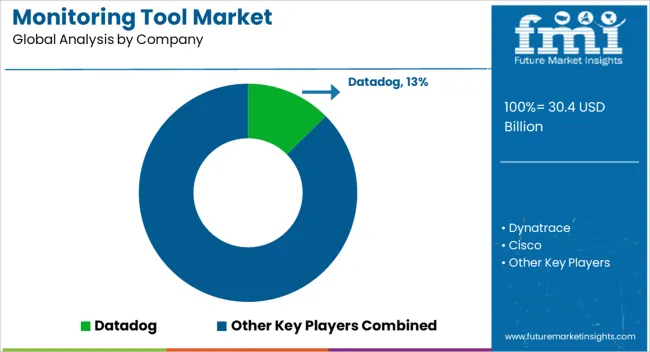
The competitive landscape of the monitoring tool market is characterized by a diverse range of players, including multinational corporations. Lucrative opportunities are held by market players that compete based on product features, pricing, reliability, and customer service.
Continuous innovation, strategic partnerships, and acquisitions are common strategies companies employ to gain a competitive edge. With the propelling demand for advanced monitoring solutions, competition in the market remains fierce due to companies’ market share and customer loyalty.
Some of the key developments are:
| Attributes | Details |
|---|---|
| Estimated Market Size in 2025 | USD 25.1 billion |
| Projected Market Valuation in 2035 | USD 170 billion |
| Value-based CAGR 2025 to 2035 | 21.1% |
| Forecast Period | 2025 to 2035 |
| Historical Data Available for | 2020 to 2025 |
| Market Analysis | Value in USD billion |
| Key Regions Covered | North America; Latin America; Western Europe; Eastern Europe; South Asia and Pacific; East Asia; The Middle East and Africa |
| Key Market Segments Covered | Component, Deployment, Type, Vertical, Region |
| Key Countries Profiled | The United States, Canada, Brazil, Mexico, Germany, The United Kingdom, France, Spain, Italy, Russia, Poland, Czech Republic, Romania, India, Bangladesh, Australia, New Zealand, China, Japan, South Korea, GCC countries, South Africa, Israel |
| Key Companies Profiled | Atera; AWS (Amazon Web Services); Better Stack; Checkmk; Cisco; Datadog; Dynatrace; Exoprise; Google; IBM; Icinga; Idera; ITRS |
The global monitoring tool market is estimated to be valued at USD 30.4 billion in 2025.
The market size for the monitoring tool market is projected to reach USD 206.2 billion by 2035.
The monitoring tool market is expected to grow at a 21.1% CAGR between 2025 and 2035.
The key product types in monitoring tool market are software and services.
In terms of deployment, cloud segment to command 57.3% share in the monitoring tool market in 2025.






Full Research Suite comprises of:
Market outlook & trends analysis
Interviews & case studies
Strategic recommendations
Vendor profiles & capabilities analysis
5-year forecasts
8 regions and 60+ country-level data splits
Market segment data splits
12 months of continuous data updates
DELIVERED AS:
PDF EXCEL ONLINE
Media Monitoring Tools Market Size and Share Forecast Outlook 2025 to 2035
Network Fault Monitoring Tools Market Size and Share Forecast Outlook 2025 to 2035
Advanced Server Energy Monitoring Tools Market Size and Share Forecast Outlook 2025 to 2035
Application Metrics and Monitoring Tools Market Analysis By Component, Mode, Deployment, Verticals, and Region through 2035
Pet Monitoring Camera Market Size and Share Forecast Outlook 2025 to 2035
Pain Monitoring Devices Market Size and Share Forecast Outlook 2025 to 2035
Dose Monitoring Devices Market - Growth & Demand 2025 to 2035
Brain Monitoring Market Size and Share Forecast Outlook 2025 to 2035
Motor Monitoring Market Size and Share Forecast Outlook 2025 to 2035
Neuro-monitoring System Market Size and Share Forecast Outlook 2025 to 2035
Noise Monitoring Devices Market Size and Share Forecast Outlook 2025 to 2035
Nerve Monitoring Devices Market Insights - Growth & Forecast 2025 to 2035
Power Monitoring Market Report - Growth, Demand & Forecast 2025 to 2035
Urine Monitoring Systems Market Analysis - Size, Trends & Forecast 2025 to 2035
Brain Monitoring Systems Market is segmented by Lateral Flow Readers and Kits and Reagents from 2025 to 2035
Flare Monitoring Market
Yield Monitoring Systems Market
Driver Monitoring System Market Growth - Trends & Forecast 2025 to 2035
Tunnel Monitoring System Market Growth - Trends & Forecast 2025 to 2035
Patient Monitoring System Market Size and Share Forecast Outlook 2025 to 2035

Thank you!
You will receive an email from our Business Development Manager. Please be sure to check your SPAM/JUNK folder too.
Chat With
MaRIA